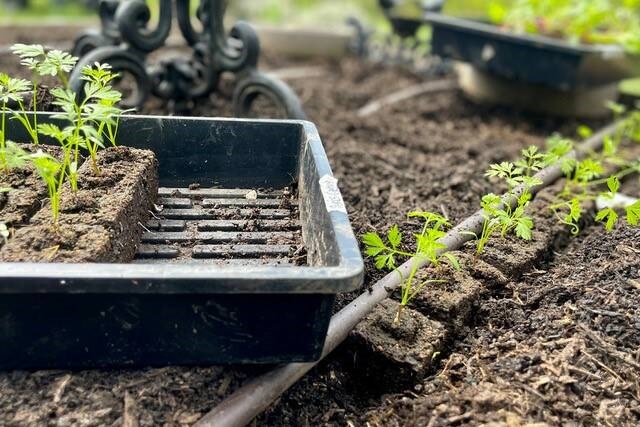One of the first things we did while converting our front yard into an urban permaculture farm of sorts, was invest in drip irrigation.
Water conservation and convenience notwithstanding, slow and consistent drip hydration at soil level combined with substantial mulching, helps plants manage extreme heat, drought, wind, cold and predation, while increasing yield and ecosystem health overall.
In urban settings, a surprising percentage of the rain that falls on our properties does not stay in place, rather it is directed off-property into gutters, sewers and drainage infrastructure. It is hard to believe this is the case when an atmospheric river is raining buckets, but it is so.
Consequently, plants need all the help they can get to attract and hold water into their rhizospheres, the “soil neighborhoods” that include and surround their root zones. Like all living things, soil biology needs water to survive. Cut off the water supply, and death occurs. Interrupt it, and trigger a cascade of imbalances.
Moist living soil – meaning soil rich in organic matter and microorganisms – will by its very nature attract and hold water. Bare, dry soil most often resists absorption, and runoff occurs.
Drip irrigation distributes moisture slowly through in-line emitters. Gravity pulls the water down, and capillary action carries it horizontally through voids created by biology, designing ultimately, a pyramid shaped wet zone in the rhizosphere. When mulched, this wet zone resists evaporation and run-off.
Plants that experience drought stress exhibit visible and invisible changes designed to conserve water and reduce harm. Plants may shed leaves to minimize water loss through transpiration, or close the tiny leaf pores (stomata) that regulate the exchange of gases.
Fibre growth may be inhibited in exchange for increased root growth as plants search further and deeper for water. Plant cells may collapse and dehydrate, causing wilting, yellowing, browning and even death.
Physiological changes related to drought stress weaken plants’ natural immunity to pests and disease.
Thankfully, with a little bit of time and an investment in driplines, fittings and mulch, we can protect our plants from drought stress and many other stresses, and at the same time keep more water in-place where it is needed.
Starting plants seeds in soil blocks is a cost-effective, plastic-free and simple way to prepare plants for optimal uptake of water and soil-borne nutrients. Plants “air prune” their roots in soil blocks, automatically splitting and branching off new growth as they hit air bordering the sides and bottom of the blocks. Plant roots in pots bounce off the sides, creating the familiar tangle if left too long.
Soil-blocked seedlings hit the ground running, literally, the minute the many branches of their air-pruned roots hit new soil.
We started seedlings indoors during the third week of March. They germinated quickly in warm, micro soil blocks, and were soon “potted up” into two-inch soil blocks.
After a few days growing under natural light and hardening off in the greenhouse, they were planted alongside driplines in our raised beds. The deep leaf and hemp mulch was tucked around the plants, insulating them from cold and hiding the dripline.
The plants will continue to grow slowly in the cool weather, self-hardening off, establishing deep root structures and building resilience. We will drape fleece over the beds in case of late frost.
Tomatoes, peppers, cucumbers and melons remain in their soil blocks alongside newly blocked peas and beans, in the now gently heated greenhouse. Soon, the benches will be empty, the beds will be full and the race will be over.
Laura Marie Neubert is a West Vancouver-based urban permaculture designer. Follow her on Instagram @upfrontandbeautiful, learn more about permaculture by visiting her Upfront & Beautiful website or email your questions to her here.
For a taste of permaculture, watch the video below:




